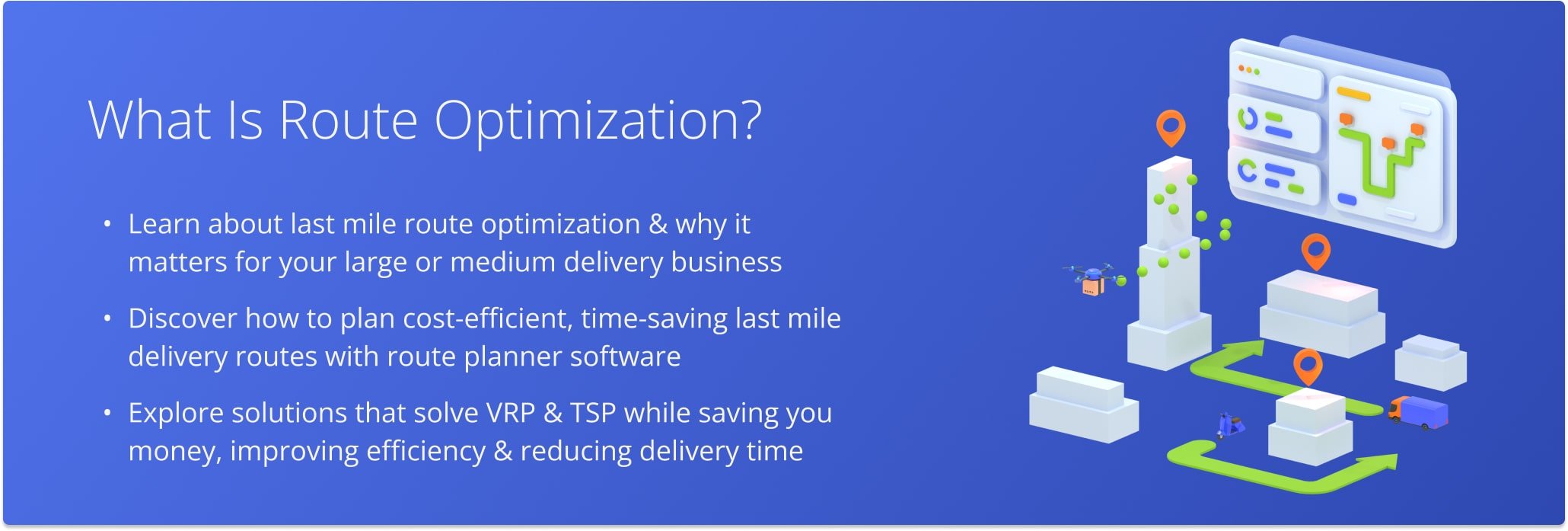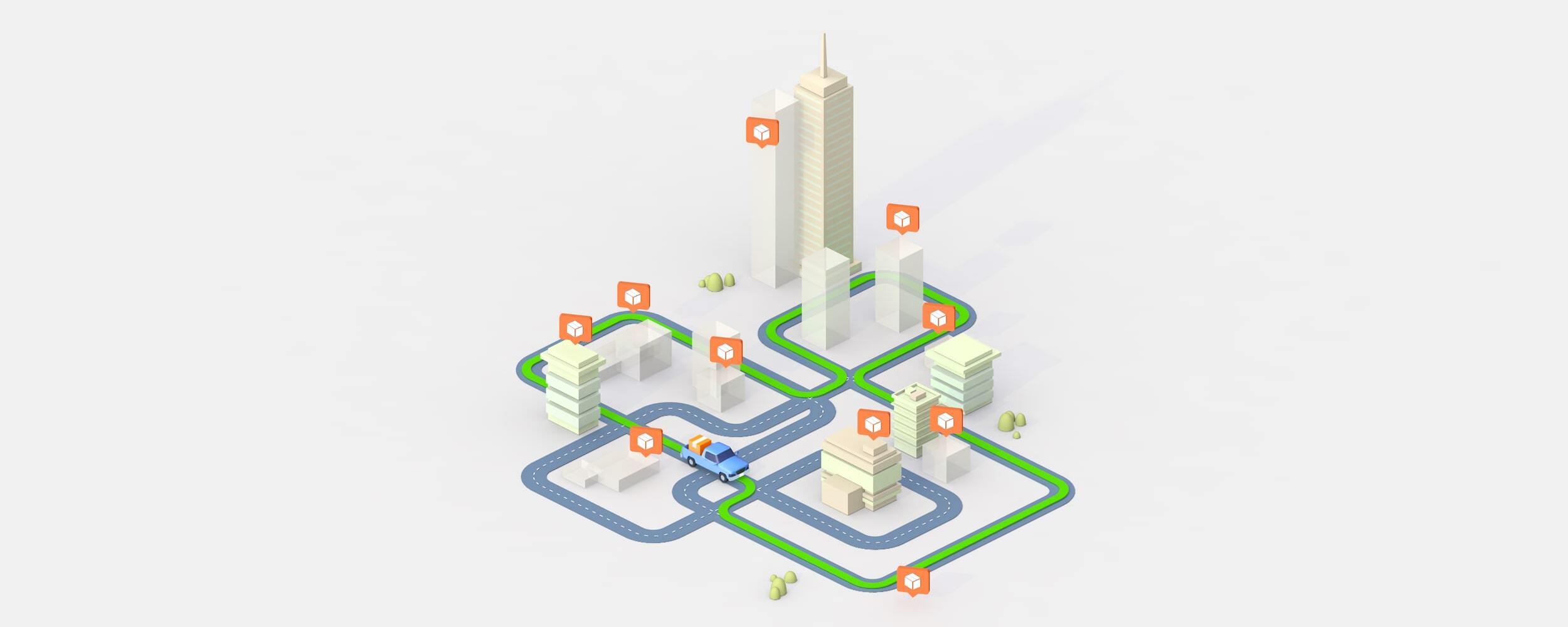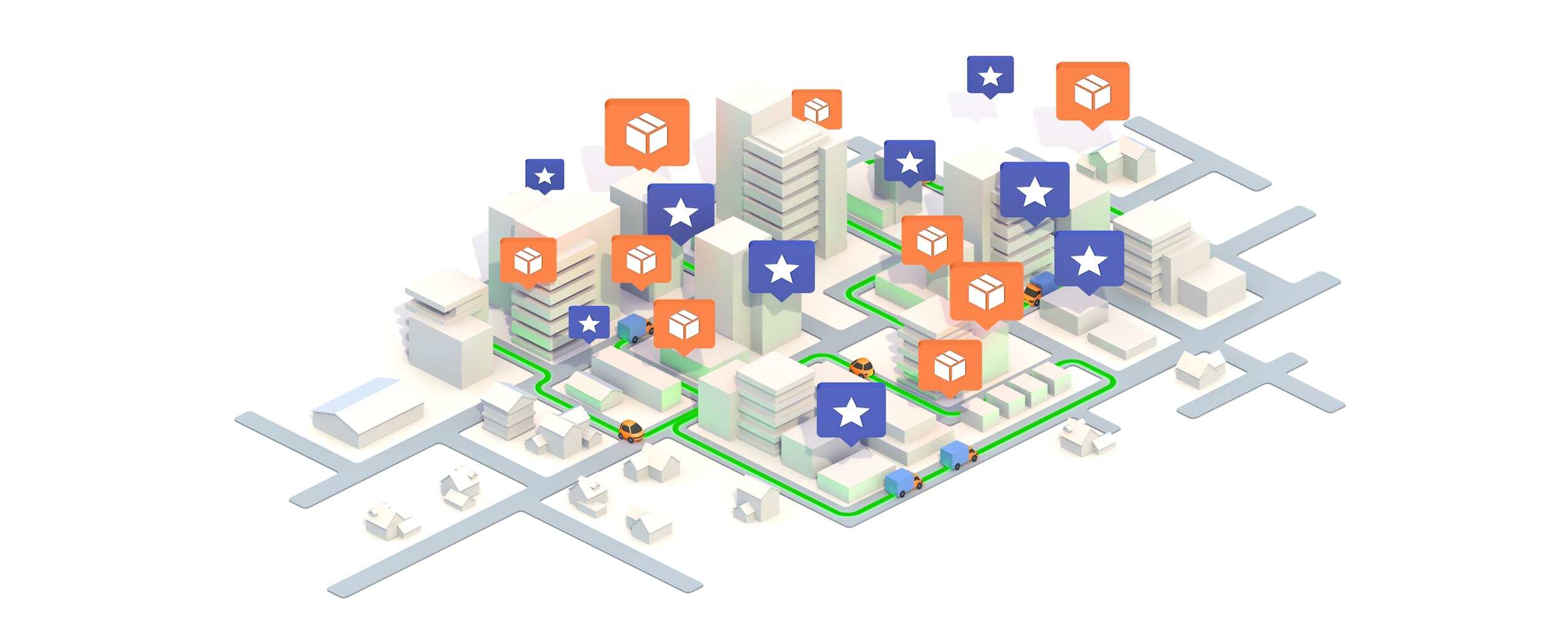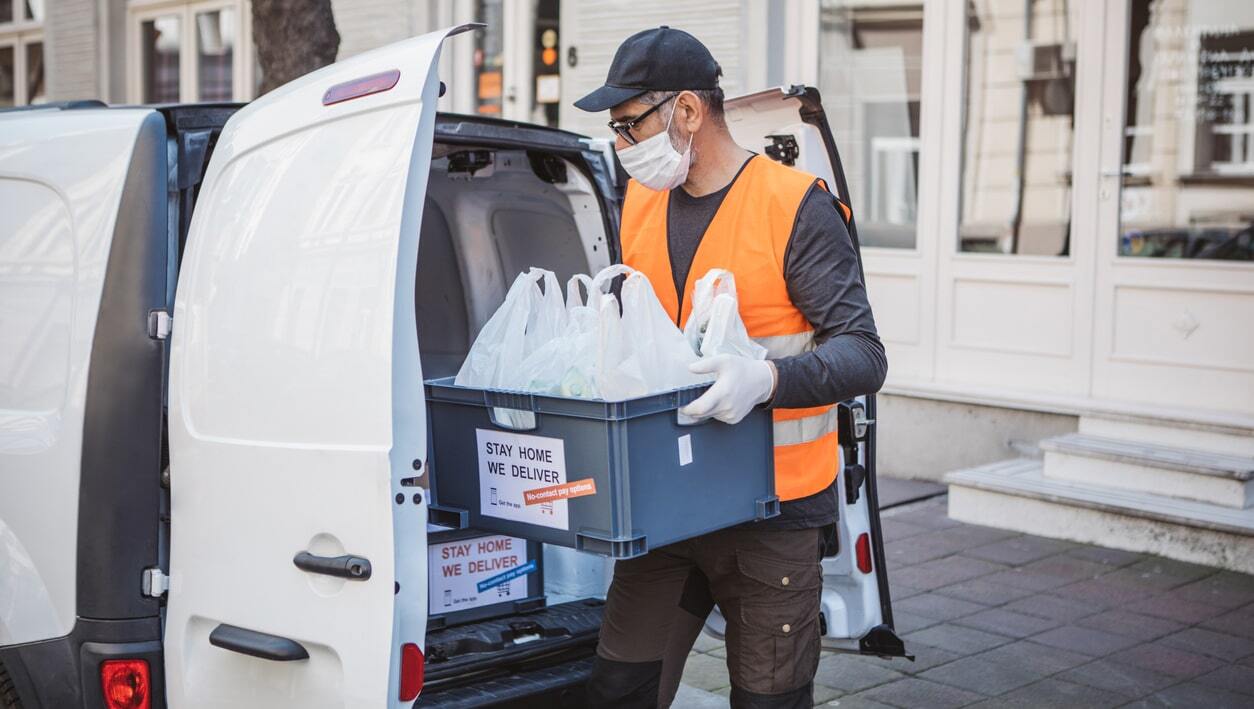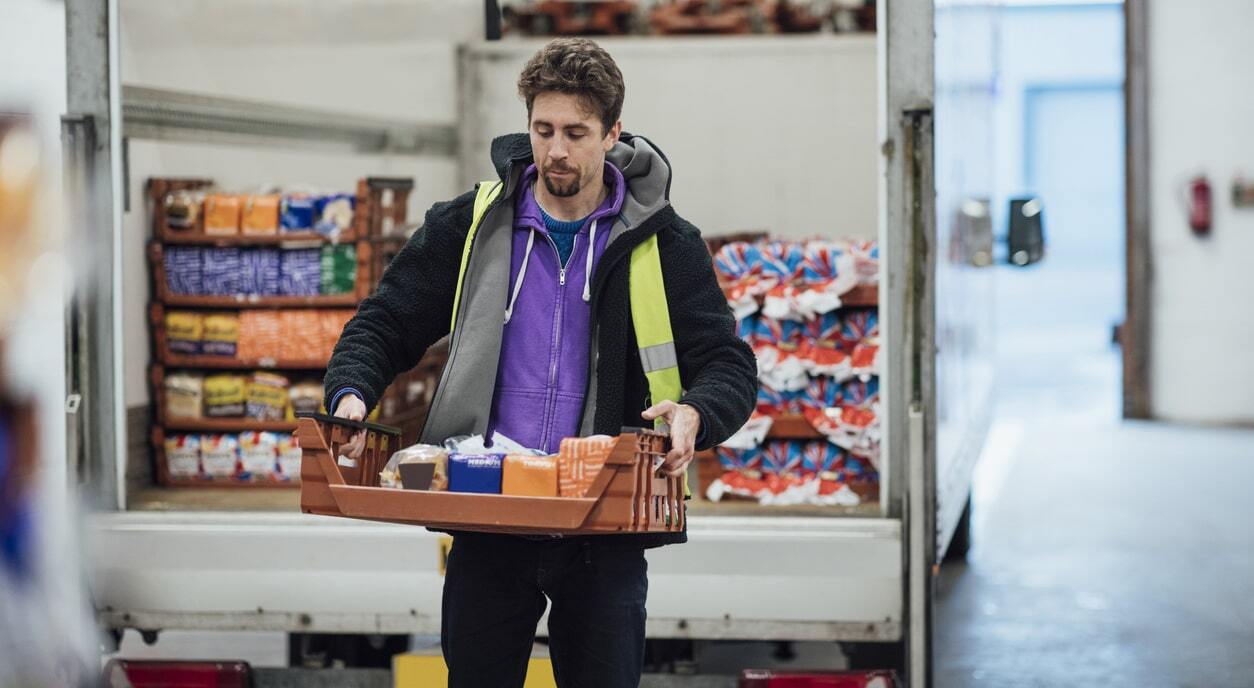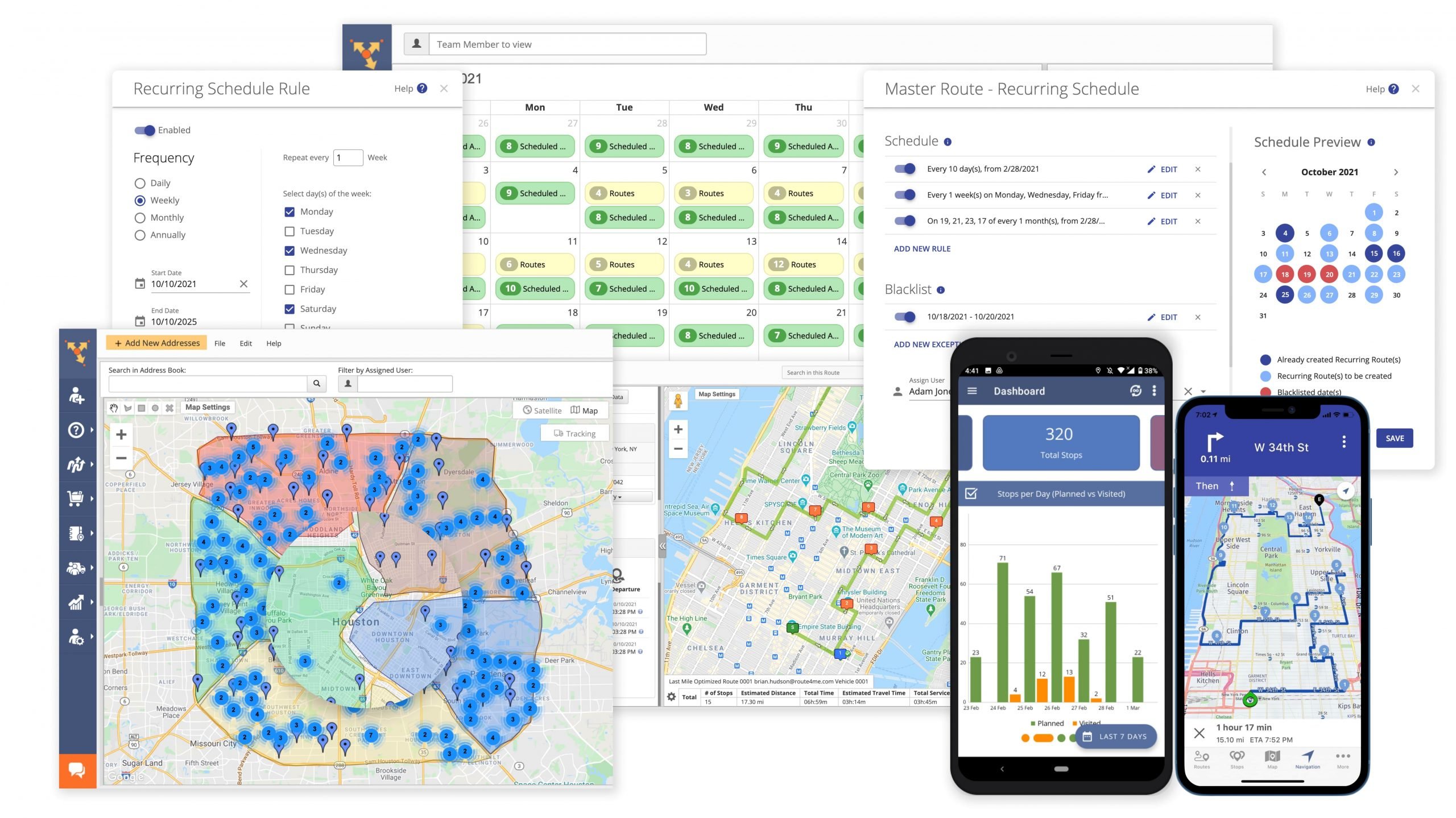What Is Route Optimization In 2025? Trends And Best Software
In an increasingly delivery-reliant world, route optimization and strategic cycle planning differentiate mediocre delivery services from the best-in-class last mile carriers. Modern consumers want to use convenient and mobile-friendly tools to make product and service orders. Furthermore, customers expect fast and on-time delivery, delivery location selection tools, free shipping, and other benefits offered by such giants as Amazon, UPS, FedEx, etc.
Therefore, all last-mile businesses and carriers need to keep their competitive edge and use route optimization to:
- Make route planning processes faster and more streamlined
- Automate delivery routing and delivery scheduling
- Make more deliveries faster and cheaper
- Deliver more without additional drivers and vehicles
- Optimize mobile workforce and fleet management
- Equally distribute workload among delivery drivers, sales reps, field marketing reps, etc.
- Delight customers with on-time deliveries and services
- Always plan the fastest route to any customer destination
- And a lot more!
By reading this article, you will learn about what route optimization entails, what is the route optimization definition, how FedEx and UPS optimize their routes, and more.
Table of Contents
The Definition of Route Optimization
The definition of route optimization explains the process of determining the fastest route to visit multiple destinations in the most optimal sequence. However, route optimization is not only about calculating the fastest route with multiple stops – especially when it comes to delivery logistics businesses.
In this article, you can learn about the differences between route planning and route optimization, what dynamic routing is and what type of businesses need it, the most frequently asked questions about route optimization asked by Route4Me customers, and more. Plus, by reading further, you’ll also discover multiple inspiring route optimization case studies and success stories as well as the easiest delivery routing software you can use today.
Route Planning vs Route Optimization
Route planning is the process of manually sequencing multiple addresses to create a route. In comparison, route optimization is the process of automatically computing the optimal address order and creating the fastest route possible.
Usually, logistics software designed for commercial use features both these processes, offering users the ability to plan and optimize routes in seconds. On the other hand, free route planning software solutions offer basic address mapping services without any business route optimizer tools or capabilities.
Consequently, last mile businesses and field-oriented organizations opt for route optimization software that can accommodate their logistics needs rather than resuming to a simple mapping service like the Google route planner or the Waze navigation app. For example, Route4Me’s route optimizer solution gives fleet managers, dispatchers, and route planners the ability to input a set of business rules and customer variables and then automatically sequence destinations for the shortest driving directions and fast travel time between each destination.
Route Optimization Frequently Asked Questions
Below, our delivery route optimization experts collected and answered the most common routing, scheduling, and optimization FAQs that our customers have asked over the last decade.
Route optimization is the process of mapping and calculating the most efficient route a vehicle can navigate in order to visit multiple addresses or locations. Furthermore, route optimization is often associated with solving the Travelling Salesman Problem (TSP) or its simplified version, the Vehicle Routing Problem (VRP). Oftentimes, multiple operational constraints are taken into consideration when optimizing routes. For example, Route4Me’s route optimizer software enables you to account for such constraints as:
The route optimization problem is a simplified term that refers to the Travelling Salesman Problem (TSP) and the Vehicle Routing Problem (VRP) – two NP-hard combinatorial optimization problems that aim at finding the fastest and/or the shortest path between two points (addresses, destinations, locations, etc.). Usually, the VRP aims to calculate the most efficient route a vehicle can travel from a transportation hub to a specific set of addresses. On that note, solving the route optimization problem helps logistics intense businesses to maximize performance and increase the profitability of their last mile routes. Furthermore, the last mile is the most expensive process of a distribution network, accounting for as much as 41% of the total supply chain costs. And a big portion of these expenses is the consequence of unoptimized routes. Thus, by solving the route optimization problem, logistics businesses can:
Route optimization works by calculating the best route that services all the provided addresses in the most time-efficient and cost-effective manner. Since manually optimizing routes with multiple stops is a close to impossible task, most of today’s businesses use route optimization software. On that note, here’s how route optimization works when using a route planner such as Route4Me:
Route optimization is important for field-oriented and last mile businesses as it’s an invaluable source of cost-cutting, time-saving, and revenue-generating benefits for the last mile. For example, optimizing routes with Route4Me enable last mile carriers and field service businesses to:
Dynamic route optimization or dynamic routing is the optimization process that enables professionals to plan flexible routes every day while being able to recalculate and re-optimize routes to reflect last-minute changes in real-time. Its versatility makes dynamic routing suitable for any logistics intense business whose routes are changing on a daily basis. By contrast, static routing involves creating fixed routes that do not support major edits. Furthermore, static routes follow a recurring delivery schedule. Specifically, routes with rigid schedules might be suitable for garbage disposal, bus scheduling, subscription-based deliveries, snow clearing, and other schedule-dependent activities. With Route4Me, logistics businesses can do both. Namely, Route4Me’s route optimization software offers users the possibility to:
Route optimization in logistics refers to the process of finding the most optimal routes for warehouse order pickers, last mile drivers, middle mile drivers, etc. In detail, logistics optimization has a key role in the entire supply chain as it helps logistics professionals cut transportation costs at any stage – from warehouses and fulfillment centers to middle mile and last mile delivery. Specifically, logistics businesses use route optimization software to ensure their field employees and warehouse staff drive the shortest and fastest routes while minimizing idling. For example, organizations that use Route4Me, manage to: Keep on reading to learn more about the benefits of route optimization and logistics optimization.
Route optimization software is a digital tool for automatically calculating the most efficient driver routes that service multiple addresses. Route optimization software usually comes in the form of web-based platforms and mobile apps that enable users to solve the Vehicle Routing Problem with added layers of complexity and business-specific customization. For example, Route4Me’s route optimization software and delivery route app are capable of planning the most cost-efficient and time-effective routes with hundreds of thousands of addresses while factoring in constraints such as:
To optimize a route, you need to plan a route manually and calculate the most optimal stop sequence yourself or use route optimization software. The first option is time-consuming and highly ineffective. By contrast, using route optimization software helps businesses plan routes with hundreds of thousands of addresses accounting for complex business needs in just a couple of seconds. For example, to optimize a route with Route4Me’s route optimization software, you have to follow a few simple steps: With Route4Me’s easiest route optimizer, optimizing delivery routes takes less than a minute! Plus, you can customize your routes with a wide selection of route optimization constraints. In this way, you can fine-tune your optimized routes to perfectly accommodate your unique logistics requirements.
When optimizing routes with route planning software, you have the ability to constrain the system to account for different custom rules called route optimization constraints. These rules are also commonly referred to as business rules and customer variables. For example, Route4Me’s route optimization software supports multiple route optimization constraints and rules, including:
To optimize delivery and cut fuel costs, deliver more packages, and utilize fleets at their full capacity, businesses have to optimize their routes first. With route optimization software, last mile carriers can centralize their fleet management processes, track drivers in real time, and streamlined route dispatch. For example, businesses that optimize their delivery processes with Route4Me’s route optimization software can:
No, Google Maps route planner can’t optimize routes because it can’t automatically sequence multiple addresses in an optimal visitation order. However, the Google Maps app is capable of planning routes with up to 10 addresses in a custom sequence and does not feature any route optimization tools. Thus, users have to calculate the most optimal stop sequence themselves and order addresses manually in the preferred position within a route. Therefore, “route optimization” with Google Maps is suitable for personal use only and not for commercial routing. So, field-oriented businesses should switch from Google routing to route optimization software for better results. For example, with Route4Me, you can automatically plan optimized routes with hundreds of thousands of addresses in a few seconds.
To optimize routes with multiple stops using Google Maps, follow these simple steps: As you can probably already tell, Google Maps doesn’t enable users to optimize routes automatically. So, when using Google’s route planner to plan multi-stop routes, you have to calculate the most optimal way to sequence your addresses by yourself. By contrast, route optimization software gives logistics professionals the ability to plan optimized routes with unlimited stops in seconds. For example, Route4Me’s route optimization software and Google Maps alternative route planner enable you to automatically optimize multi-stop routes with hundreds of thousands of destinations.
Waze’s free navigation app doesn’t give you the ability to optimize routes with multiple stops. However, with Waze, you can plan routes with up to 3 stops. Namely, after selecting your departure and destination addresses, you are able to insert one more stop between the route start and route end. So, Waze is a great mapping app for getting the fastest driving directions from point A to point B but is not suitable for commercial grade route planning. Instead, if you want to optimize routes with more than 3 stops, you should look into Waze alternatives created for business use, such as Route4Me, Onfleet, MyRouteOnline, Optimoroute, Routific, etc. Discover more about Waze route optimization alternatives below.
UPS optimizes routes using ORION, their proprietary route optimization software. In detail, ORION stands for On-Road Integrated Optimization and Navigation, a system that combines artificial intelligence and machine learning for computing workable routes for UPS drivers. Furthermore, UPS’s routing technology features a left turn avoidance tool that helped the company drive significant savings. Similarly, Route4Me’s route optimization software gives users the opportunity to follow the UPS delivery routing model by avoiding left turns (or right turns in left-hand traffic countries). Particularly, when planning left-turn-free routes, last mile delivery and field-oriented businesses are able to: Read more about the benefits you can leverage with Route4Me’s left turn avoidance feature.
FedEx optimizes routes for their last mile deliveries using dynamic route optimization (DRO) technology. The FedEx DRO software was developed in-house and was released in 2019. Since then, the DRO software not only plans optimized routes, but also offers real-time insights and data about the planned routes. Moreover, DRO also provides load optimization so that the workload is fairly distributed among FedEx delivery drivers. Plus, with DRO, FedEx drivers can use multiple tools to efficiently manage and organize their delivery territories. Furthermore, FedEx’s Dynamic Route Optimization software aims to help the company keep a competitive edge among the last mile front-runners, such as UPS, Amazon, USPS, etc. You can learn more about FedEx driver jobs on their official website. Additionally, you can learn about FedEx driver salaries on such websites as Glassdoor, etc.
To optimize a truck route, you have to take into consideration the loading and carrying capacity of your truck as well as the local regulations for commercial vehicles while solving the Vehicle Routing Problem (VRP). Or, instead, you could just use a commercial truck route optimization software solution with truck routing and fleet management features. To illustrate, Route4Me’s truck routing software will effortlessly compute optimized truck routes for your delivery truck drivers while factoring in weight, height, and loading parameters for class 1-8 trucks, low clearances or bridges, HAZMAT cargo regulations,
truck road restrictions, traffic bans, plus other business-specific constraints.
To optimize a free delivery route, you can use a free route planner like Google Maps, MapQuest, or RouteXL. For instance, if you have to visit less than 10 addresses per day, you can use Google Maps for route planning. Then, you need to calculate the most optimal way to sequence your route stops. Alternatively, you can use MapQuest, RouteXL, or other free optimization tools. However, these platforms will offer you a limited routing experience and basic optimization tools that might not be able to keep up with your unique business demands. Moreover, these free online mapping tools are not suitable for commercial use. Instead, the best thing you can do is to sign up for a free route optimization software trial. For example, Route4Me offers a free route optimizer software trial for a whole week! During this time, you will get a measurable increase in productivity. Read more about our free 7-day trial below.
The best route optimization software in 2025 is the one that can accommodate the rapid market shifts, demand for convenient delivery, changing customer behaviors, and other modern-day last mile delivery challenges. For example, for small operations with only a couple of customers to visit per day, a free mapping tool such as MapQuest, Google Maps, or Waze might do the trick. On the other hand, for medium-sized businesses with more than 10 addresses to route each day and more than 1 driver, the best route optimization software would have to provide route dispatch, route optimization, and even fleet management. Furthermore, corporate giants like FedEx, UPS, and USPS have more complex logistics needs, thus the best route optimization software for these types of businesses would be a flexible, feature-rich tool that can fulfill their business needs.
Route Optimization Examples and Case Studies
Now that you have a better idea of what route optimization is and how it works, it’s time to discover real-life cases and business success stores. Read further to learn how real businesses managed to:
- Frictionlessly implement new, delivery-focused operational models overnight
- Maximize deliveries without investing in extra resources
- Saved time and made more money
- And more!
So, to better understand the impact optimized routes have on operational efficiency, read the following route optimization case studies.
ENYP – Faster Food Delivery for the Vulnerable
ENYP provides fresh food to underprivileged individuals and families. Because of the COVID-19 outbreak, ENYP had to switch from a food collection service to a delivery-focused model and partnered up with Route4Me to improve their routing processes. Specifically, ENYP was struggling with minimizing time and travel-related expenses while trying to keep up with a 357% increase in demand for their delivery services.
Route4Me’s route optimization software offered ENYP the means to quickly adapt to a new delivery-based operational model without investing in additional assets, staff, vehicles, etc.
- “The Route4Me app has been invaluable in enabling us to plan our delivery routes to multiple addresses, and coordinating our teams and volunteers for deliveries.”
Furthermore, Route4Me helped ENYP to:
- “ensure time efficiency, minimizes our travel costs, and also helps us to ensure our staff and volunteers are time efficient in their hours supporting the project.“
ACORx – More Medication Adherence Packaging (MAPS) Delivered to Those in Need
ACORx pharmacy helps people stay on track with their prescriptions by delivering pre-organized medications to over 100 patients in Western Pennsylvania daily. Since ACORx manages deliveries in house, they started looking for a method to minimize their operational expenses and improve fleet efficiency.
Consequently, ACORx started using Route4Me’s route planning and optimization solutions to make their last mile processes more profitable and seamlessly switch to a contactless delivery model. As soon as they started to manage their logistics operation with Route4Me, ACORx improved their last-mile delivery operations in terms of “time and expense savings.”
And as for the newly implemented contactless delivery service, ACORx made great use of Route4Me’s iOS Route Planner and Android Route Planner apps. Particularly, the ACORx drivers found our route planner’s electronic proof of delivery (ePOD) features especially convenient.
More Route Optimization Case Studies
But that’s not all! Get inspired by other businesses’ route optimization success stories, and discover how Route4Me helped other logistics intense organizations attain their operational goals. For example:
- Sunrise Cafe New Haven managed to increase deliveries from 20 families to over 2,000
- ORGANICYCLE LLC started using Route4Me’s route planner to expand their business and go from 400 route stops up to a thousand
- And many more!
Route Optimization Software 2025
In 2025, competition is at its peak among last-mile carriers. Particularly, the COVID 19 pandemic opened new opportunities and raised new challenges for last mile businesses as the demand for home delivery went through the roof. As a result, to gain an edge over the competition, carriers are always on the lookout for the best route optimization software.
Route4Me Last Mile Optimization Software
Route4Me’s enterprise-grade route optimization software is today’s most used routing service in the world, suitable for any business size. Furthermore, our route planning and optimization platform offers logistics intense businesses the support they need to plan, optimize, schedule, and dispatch their multi stop routes.
- Deliver more with less
- Use a wide range of customer variables
- Maximize fleet profitability and use fewer vehicles to cover the same workload
- Get more accurate estimates for how many vehicles and drivers are necessary to complete your deliveries
- Improve their business’s bottom line
- And much more!
Moreover, Route4Me’s Android Route Planner and iPhone Route Planner mobile apps double as driver apps and mobile route management apps. Particularly, our apps provide flexible features for delivery drivers and field employees as well as dispatchers, route planners, and fleet managers. Specifically, the Route4Me Route Planner apps offer voice-guided, turn-by-turn navigation, route optimization, ePOD collection capabilities, and a lot more! Furthermore, on the web-enabled routing platform, Route4Me customers can:
Free Optimization Software Trial
Ready to give the best route optimization software in 2025 a try?
Route4Me offers new customers a free optimization software trial for a whole week. That means you can easily plan unlimited routes with your own routing data for 7 days without any charge. Moreover, you don’t even need your credit card when signing up for the get started.
So, are you ready to register for the best route planning software get started?
Begin your get started and discover how Route4Me can help you achieve a 300% increase in your operational efficiency.
All the trademarks, logos, and brand names on this page are for identification purposes only. We do not endorse these trademarks, logos, and brand names. All the trademarks, logos, and brand names are the property of their respective owners. If any of the trademarks, logos, and brand names are your property or the property of your company, and you would like us to remove them from our website, please contact us at [email protected] to submit your request.
Visit Route4Me's Marketplace to Check out Associated Modules:
- Routing Business Rules
Business Rule - Max Stops Per Route
- Operations
Advanced Team Management Add-On
- Operations
Audit Logging and Activity Stream
Last Updated:
